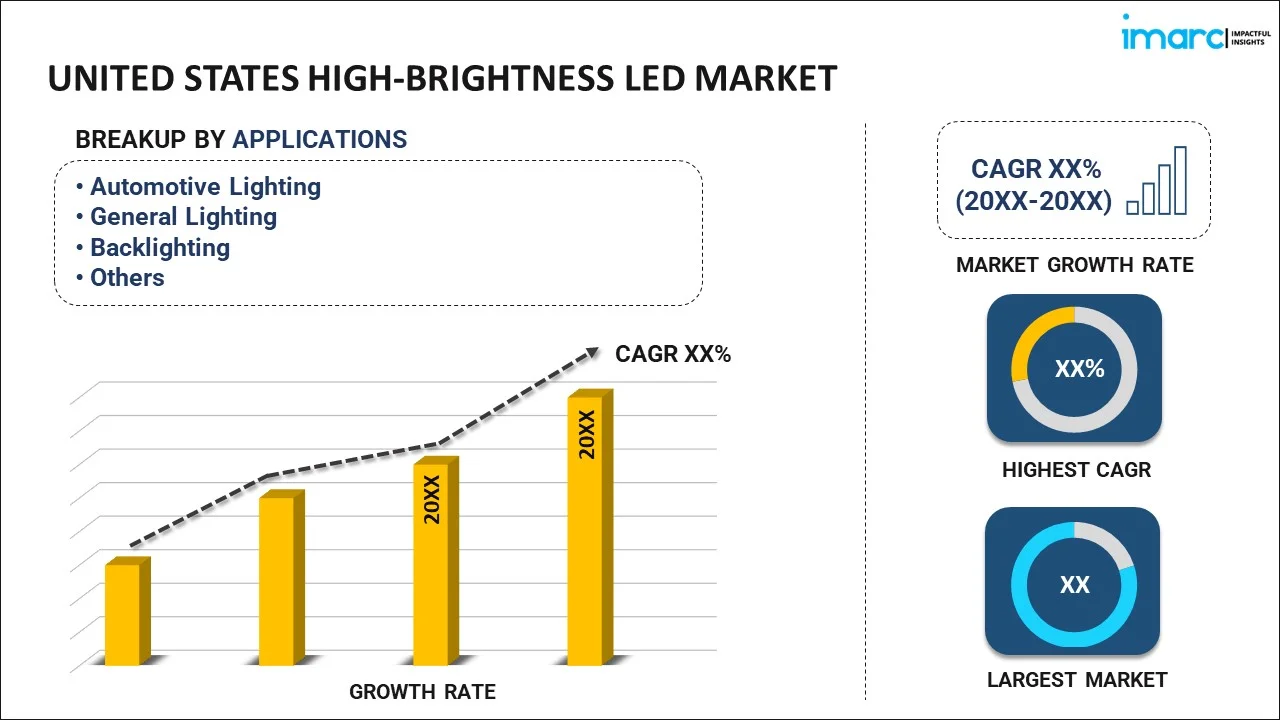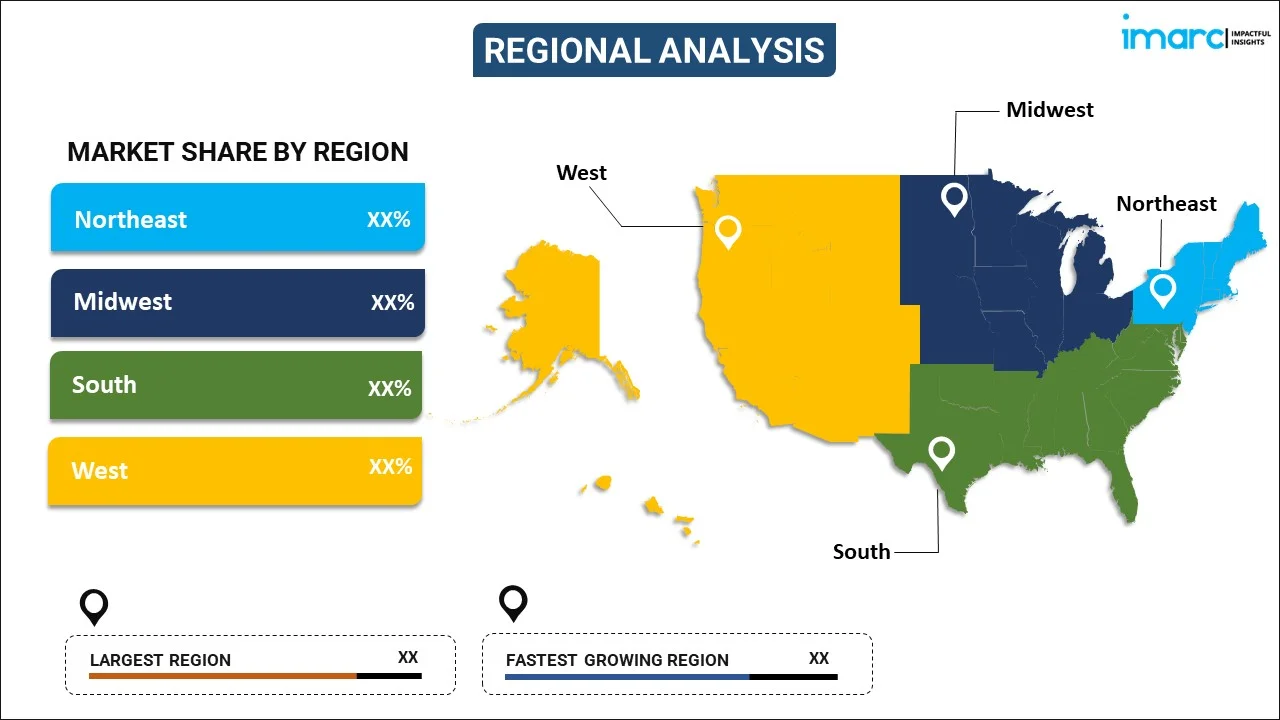
United States High-Brightness LED Market Report by Application (Automotive Lighting, General Lighting, Backlighting, Mobile Device, Signals and Signage, and Others), and Region 2025-2033
Market Overview:
United States high-brightness LED market size reached USD 6.8 Billion in 2024. Looking forward, IMARC Group expects the market to reach USD 16.8 Billion by 2033, exhibiting a growth rate (CAGR) of 10.5% during 2025-2033. The increasing trend towards smart homes, buildings, and cities, which involves the integration of lighting systems with the Internet of Things (IoT), is driving the market.
|
Report Attribute
|
Key Statistics
|
|---|---|
|
Base Year
|
2024
|
|
Forecast Years
|
2025-2033
|
|
Historical Years
|
2019-2024
|
|
Market Size in 2024
|
USD 6.8 Billion |
|
Market Forecast in 2033
|
USD 16.8 Billion |
| Market Growth Rate 2025-2033 | 10.5% |
High-brightness LEDs (HBLEDs) are advanced light-emitting diodes designed to produce intense illumination efficiently. Unlike traditional LEDs, high-brightness LEDs generate significantly higher light output per unit of electrical power, making them ideal for applications demanding intense brightness. They are commonly used in various fields, including automotive lighting, signage, display technology, and general lighting. High-brightness LEDs incorporate advanced semiconductor materials and designs to achieve superior performance. The efficiency of these LEDs is attributed to their ability to convert a higher percentage of electrical power into visible light, minimizing energy wastage in the form of heat. This efficiency, coupled with their long lifespan and compact size, has contributed to their widespread adoption of energy-efficient lighting solutions. As technology advances, continuous improvements in the design and production of high-brightness LEDs continue to enhance their brightness, reliability, and versatility, paving the way for innovative lighting applications across different industries.
United States High-Brightness LED Market Trends:
The high-brightness LED market in the United States is experiencing robust growth, driven by several key factors. Firstly, the increasing demand for energy-efficient lighting solutions has propelled the adoption of high-brightness LEDs across various applications. Moreover, the regional push towards sustainability and environmental conservation has encouraged the replacement of traditional lighting sources with LEDs, contributing significantly to market expansion. Furthermore, advancements in LED technology, including improvements in luminous efficacy and color rendering, have enhanced the overall performance of high-brightness LEDs, making them an attractive choice for diverse lighting applications. In addition to this, government initiatives and regulations promoting energy efficiency and the phase-out of incandescent bulbs have further accelerated the demand for high-brightness LEDs. The ongoing trend of smart lighting systems and the integration of LEDs in IoT applications have opened up new avenues for market growth. The automotive industry's increasing adoption of high-brightness LEDs in headlights, brake lights, and interior lighting has also played a pivotal role in driving market demand. Collectively, these interconnected factors underscore the dynamic landscape and promising future of the high-brightness LED market in the United States.
United States High-Brightness LED Market Segmentation:
IMARC Group provides an analysis of the key trends in each segment of the market, along with forecasts at the country level for 2025-2033. Our report has categorized the market based on application.
Application Insights:

- Automotive Lighting
- General Lighting
- Backlighting
- Mobile Device
- Signals and Signage
- Others
The report has provided a detailed breakup and analysis of the market based on the application. This includes automotive lighting, general lighting, backlighting, mobile device, signals and signage, and others.
Regional Insights:

- Northeast
- Midwest
- South
- West
The report has also provided a comprehensive analysis of all the major regional markets, which include Northeast, Midwest, South, and West.
Competitive Landscape:
The market research report has also provided a comprehensive analysis of the competitive landscape. Competitive analysis such as market structure, key player positioning, top winning strategies, competitive dashboard, and company evaluation quadrant has been covered in the report. Also, detailed profiles of all major companies have been provided.
United States High-Brightness LED Market Report Coverage:
| Report Features | Details |
|---|---|
| Base Year of the Analysis | 2024 |
| Historical Period | 2019-2024 |
| Forecast Period | 2025-2033 |
| Units | Billion USD |
| Scope of the Report | Exploration of Historical Trends and Market Outlook, Industry Catalysts and Challenges, Segment-Wise Historical and Future Market Assessment:
|
| Applications Covered | Automotive Lighting, General Lighting, Backlighting, Mobile Device, Signals and Signage, Others |
| Regions Covered | Northeast, Midwest, South, West |
| Customization Scope | 10% Free Customization |
| Post-Sale Analyst Support | 10-12 Weeks |
| Delivery Format | PDF and Excel through Email (We can also provide the editable version of the report in PPT/Word format on special request) |
Key Questions Answered in This Report:
- How has the United States high-brightness LED market performed so far and how will it perform in the coming years?
- What has been the impact of COVID-19 on the United States high-brightness LED market?
- What is the breakup of the United States high-brightness LED market on the basis of application?
- What are the various stages in the value chain of the United States high-brightness LED market?
- What are the key driving factors and challenges in the United States high-brightness LED?
- What is the structure of the United States high-brightness LED market and who are the key players?
- What is the degree of competition in the United States high-brightness LED market?
Key Benefits for Stakeholders:
- IMARC’s industry report offers a comprehensive quantitative analysis of various market segments, historical and current market trends, market forecasts, and dynamics of the United States high-brightness LED market from 2019-2033.
- The research report provides the latest information on the market drivers, challenges, and opportunities in the United States high-brightness LED market.
- Porter's five forces analysis assist stakeholders in assessing the impact of new entrants, competitive rivalry, supplier power, buyer power, and the threat of substitution. It helps stakeholders to analyze the level of competition within the United States high-brightness LED industry and its attractiveness.
- Competitive landscape allows stakeholders to understand their competitive environment and provides an insight into the current positions of key players in the market.
Need more help?
- Speak to our experienced analysts for insights on the current market scenarios.
- Include additional segments and countries to customize the report as per your requirement.
- Gain an unparalleled competitive advantage in your domain by understanding how to utilize the report and positively impacting your operations and revenue.
- For further assistance, please connect with our analysts.
 Inquire Before Buying
Inquire Before Buying
 Speak to an Analyst
Speak to an Analyst
 Request Brochure
Request Brochure
 Request Customization
Request Customization




.webp)




.webp)












